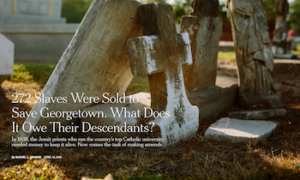
*On this date in 1838, Georgetown University's administration sold 272 African Slaves.
These humans were loaded on ships at an active landing stage in the nation’s capital, intended for the plantations of the Antebellum South. Some slaves pleaded for rosaries as they were rounded up, praying for deliverance. No one was spared: babies, mothers, not the field hands, not the shoemaker, and not Cornelius Hawkins, who was about 13 years old when he was forced onboard.
The enslaved Africans had belonged to the nation’s most prominent Jesuit priests of the day. They were sold, along with scores of others, to help secure the financial future of the premier Catholic institution of higher learning at the time, known today as Georgetown University. At Georgetown, slavery and scholarship were inextricably linked. The college relied on Jesuit plantations in Maryland to help finance its operations. Prosperous white parishioners donated Slaves, and the Rev. Thomas F. Mulledy, president of Georgetown from 1829 to 1838 and again from 1845 to 1848, arranged the sale.
The 1838 sale, worth about $3.3 million in today’s dollars, was organized by two of Georgetown’s early presidents, both Jesuit priests. Some of that money helped to pay off the 19th-century debts of the (then) struggling college.